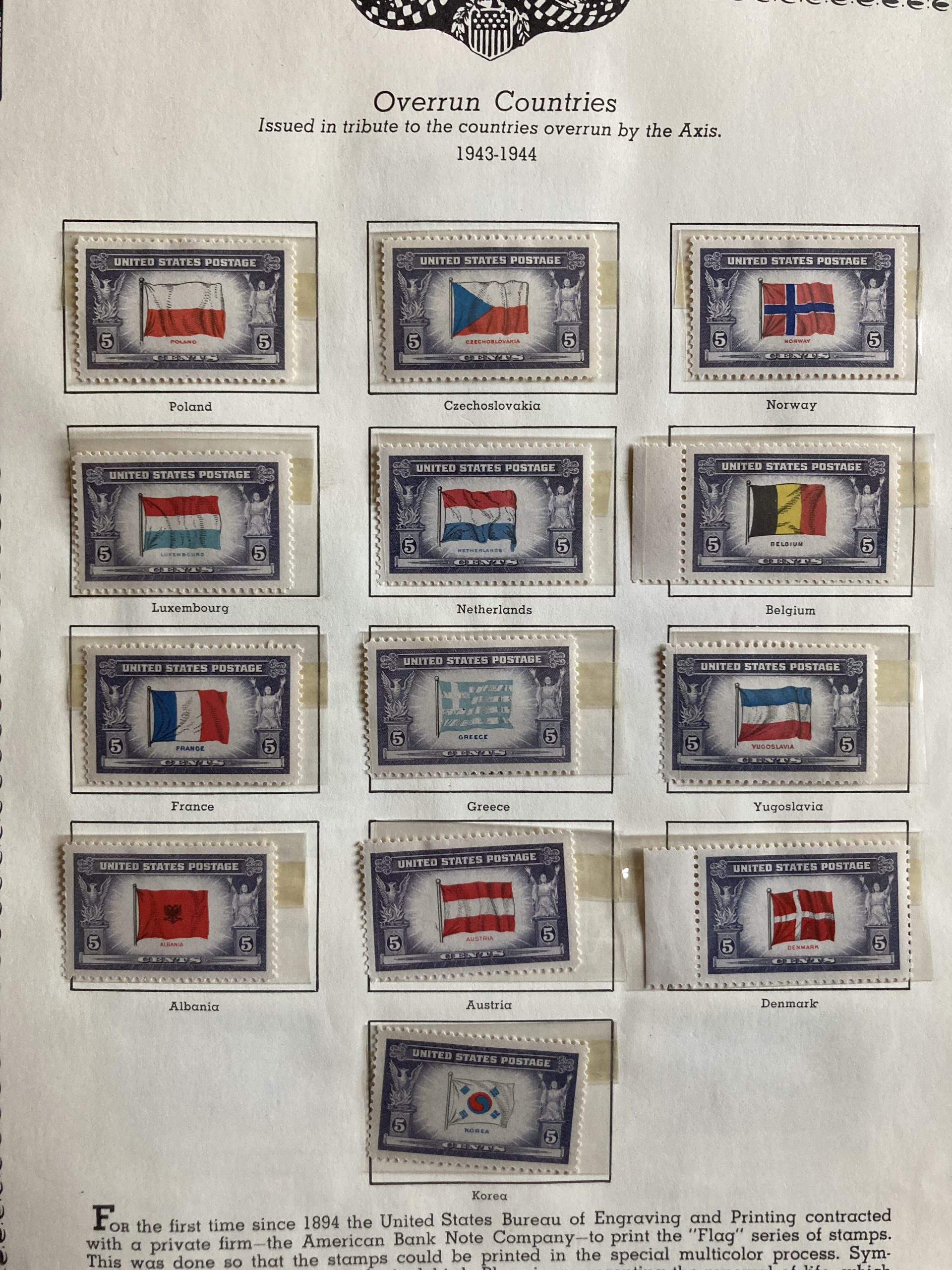
Part I:
My first serious hobby was philately . . . I didn't know it as "philately" until Tom Lehrer rhymed it with Lady Chatterley.
My first serious hobby was philately. At age 8, I knew it as stamp collecting. I didn’t know it as “philately” until Tom Lehrer rhymed it with Lady Chatterley in his song having nothing to do with philately, which, I suppose, was the point. My brothers and I started out with my mother buying stamps from the H.E. Harris stamp company by mail, and “on approval.” That meant H.E. Harris would send stamps in glassine envelopes, and if we liked them, we’d pay 25 cents or so for the stamps in the envelopes that we liked, and send the rest back. When they arrived, my brothers and I would sit in a circle and select each stamp one at a time. I loved the U.S. stamps. Each one, to my mind, was a miniature piece of art that also told a story. So we put them in albums and learned a bit about the world, this country, its history, geography, and people.
One day our mother came home from a trip where, as best I can now reconstruct it, she returned from the Midwest after disposing of property from her mother’s estate in Illinois. Her return flight went through Kansas City, where she bought stamps for postcards at a vending machine and discovered that they were old commemoratives from the early 1950s. She thought we might like them, so she kept buying them until she ran out of coins. They all went into our collections. Additionally, we’d buy each new stamp at the post office which, because they welre inexpensive at three and four cents each, we’d go to the next level and buy a “plate block” – four stamps from the corner of a sheet, with the “plate number” in the corner. 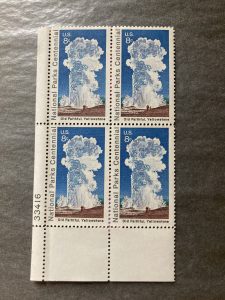 It turned out that my father had collected stamps as a young man and had an impressive set of plate blocks himself. He’d collected the “famous Americans” series, which had stamps in 3, 5, and 10 cents – so he had plateblocks that had been purchased when 40 cents was more than an hour’s wages for working people in Casper, Wyoming. By the time I got them, these plate blocks commanded a hefty price.
It turned out that my father had collected stamps as a young man and had an impressive set of plate blocks himself. He’d collected the “famous Americans” series, which had stamps in 3, 5, and 10 cents – so he had plateblocks that had been purchased when 40 cents was more than an hour’s wages for working people in Casper, Wyoming. By the time I got them, these plate blocks commanded a hefty price.
Then, the proverbial “rich uncle” died. In this case, the rich uncle was a “Cousin Elta,” a nurse in Oakland who had never married. She knew of our interest in stamps, and, when she died in about 1960, willed her “American collection” to us. Her foreign collection went to a boy of Asian descent whom she had become friends. She had a lot of early American stamps, including a mint collection of almost every airmail stamp the post office had issued, beginning in 1918, or so. The collection was missing just three air mails – the famous “Graf Zeppelin” stamps which were issued to be flown on the German dirigibles, including the Hindenburg. Very few were bought, and Cousin Elta didn’t buy any. They were also expensive, going for $.65, $1.30, and $2.65 apiece. However … she did purchase five “Baby Zeppelins” issued at about the same time. She got a block of four with the plate number, and a single stamp as well. 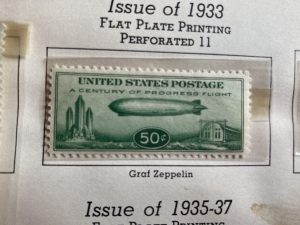 Although not quite as special as the other Zeppelins, they’re also prized by collectors, and are now quite valuable. She also had an entire set of the “Parcel Post” series, a set of 20 or so stamps with various scenes of how the post office carried packages, in trucks, by airplane, etc. They’re all red, and beautiful as well.
Although not quite as special as the other Zeppelins, they’re also prized by collectors, and are now quite valuable. She also had an entire set of the “Parcel Post” series, a set of 20 or so stamps with various scenes of how the post office carried packages, in trucks, by airplane, etc. They’re all red, and beautiful as well.
My interest in stamps faded, in part because the post office went through a period of commemorating too many things or events, and no longer issued their stamps on the engraved sheets which had so mesmerized me when I started collecting. They switched instead to stamps that looked as if they could have been printed in a cheap magazine. In short, they, to my mind, were no longer carefully produced pieces of art, and I no longer got the same joy I felt earlier from them.
It’s not always just the stamps. Sometimes the envelope tells a story. One of my favorites is a soldier’s letter with a six cent airmail stamp. Attached to it is a typed note saying it had been recovered with about 4,000 others in 1945 from a wrecked plane that had crashed two years earlier in the Aleutian Islands in the “Territory of Alaska.” 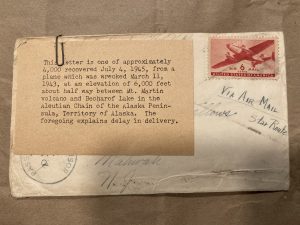 The last line laconically states “The foregoing explains delay in delivery.”
The last line laconically states “The foregoing explains delay in delivery.”
Stamps seem to have grown out of fashion, becoming more of an interest of the older generations. Younger collectors have replaced philately with baseball cards and Pikachu. And neither I nor my brothers have progeny with an interest in the subject, so the best of the stamps are now in a safe deposit box. I always look at them when I have occasion to add or remove something from the box, and I have the rest in a few albums at home that I look through every now and then. When I die I suspect my heirs will sell the stamps. I have no bitterness about this turn of events. They were a part of my growing up and I look back at them fondly.
Part II:
Hobbies are defined in some dictionaries as a spare time activity that one does for pleasure. That now defines my relationship with my clarinet. Or I should say, my clarinets, as I have them in all different keys (A, B-flat, C, D, E-flat),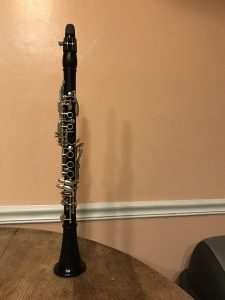 and corresponding alto, bass, and contra-bass models.
and corresponding alto, bass, and contra-bass models.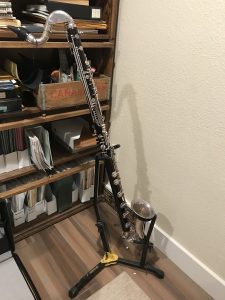 It may be erroneous to say they are a hobby; perhaps calling them an unhealthy obsession would describe them better.
It may be erroneous to say they are a hobby; perhaps calling them an unhealthy obsession would describe them better.
Our parents thought properly brought-up children would benefit from an exposure to music, so we had piano lessons, which we tolerated but didn’t particularly enjoy. There were also a few musical instruments including a trumpet and two clarinets in the house, which we were told we could play as part of the school band once we’d had a few years with the piano. The trumpet came from my mother’s father. He was a man who built pipe organs as a profession but, sadly, died before any of us met him. The clarinets were my father’s – you can see him holding one here 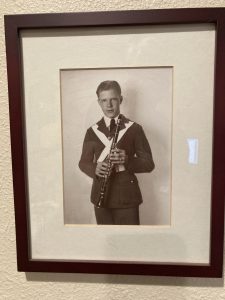 in his Casper, Wyoming American Legion band uniform. He would, on rare occasion, take the clarinet out and play the cadenza from Offenbach’s overture to “Orpheus In the Underworld”, which I would watch with rapt attention, and to which our dachshund (see my story about Bismarck) would howl in disapproval. I liked the sound of a clarinet, so that became my instrument; my twin brother got the trumpet, and our older brother got the other clarinet which he played for about two years. My clone still plays the trumpet, and I still play the clarinet.
in his Casper, Wyoming American Legion band uniform. He would, on rare occasion, take the clarinet out and play the cadenza from Offenbach’s overture to “Orpheus In the Underworld”, which I would watch with rapt attention, and to which our dachshund (see my story about Bismarck) would howl in disapproval. I liked the sound of a clarinet, so that became my instrument; my twin brother got the trumpet, and our older brother got the other clarinet which he played for about two years. My clone still plays the trumpet, and I still play the clarinet.
I fell in love with the sound of the clarinet when I heard Gershwin’s “Rhapsody in Blue,” which opens with the clarinet playing a long and low trill, rising by a glissando to a high C, and followed by repeated arpeggios, then going down the scale, through a couple of trills, and then leaping to an F above the high C, and finally back down to a mid-range G. After hearing this, I knew I had to play this instrument. The description doesn’t do it justice. Here’s a recording I just made which I thought would illustrate it better:
The sound a clarinet makes is unlike that from any other instrument. This is because the overtones or partials which one hears in addition to the fundamental frequency of each note are only half as many as what one hears with most other instruments. Simply put, the odd partials are cut out — for acoustic reasons that have never been clear to me. All I know is that a stopped cylinder, such as the clarinet, produces this type of sound. Oboes, saxophones and trumpets, being stopped cones, produce all the overtones. I don’t know how this translates to string instruments. Suffice it to say, the sound of the clarinet, when resonating in my head, keeps me coming back.
Playing the clarinet has been with me since 1962; I played steadily through middle and high school, joined a football scatter band in college, and then pretty much set it aside until after law school when I teamed up with two musicians far better than I. One majored in bassoon performance at San Jose State, but thought lawyering would be more economically stable, and the other, a clarinet player, not a lawyer, played with us as well. I joined a community band in Berkeley, and got my first crack at the aforementioned Gershwin opening to Rhapsody in Blue. I must have played it a thousand times, literally practicing in a closed closet so the neighbors wouldn’t call the cops on me for harassment.
I think what kept me going throughout my affair with the clarinet is a combination of good friends and a belief that I was better than I actually was, thereby allowing me to take on music that challenged me, and to play it without embarrassment.
In the mid-nineties I found my favorite type of music: playing classically in small groups – generally referred to as chamber music. Sacramento is a good place to do this. My wife, an oboist, and I both played in an ad-hoc group at the Attorney General’s Office, conducted by a retired music professor of whom we grew quite fond. There’s also a Sacramento “chamber music workshop” where about 20 of us form small groups and rehearse a piece for six months and have a party where each group plays a ten minute piece. (It’s nice to play and rehearse in houses where Steinways are the piano of choice!) For the past dozen years, I’ve spent a week each summer at a program at Sacramento State (named CalCAP) where about 50 musicians show up each morning at 8:00 a.m., find our names, the group we will be in, the coach, and the piece we’re playing posted on a bulletin board. We spend the day rehearsing a ten minute piece and perform it either before or after dinner. You can generally identify a diner who has yet to play – they are often too nervous to eat. I used to be nervous; not so much now.
I joined a group, “Beethoven and Friends,” with people I met at the CalCAP program. We’ve played a number of small concerts and also performed at several assisted care facilities over the years. Here’s a recording of the second of Gershwin’s Three Preludes for Piano, arranged for clarinet and piano that we performed a few years ago.
Last year, COVID cancelled the CalCAP program, so I spent much of COVID working on a solo titled “A Talk With the Unseen.” It is not for the faint of heart, prompting my teacher to say, “This is the point where you expect a snake to slither out of the piano.”
Two years ago I started my first regular lessons since high school. My teacher wasn’t sure she wanted any new students, so I lured her with the promise of working with her with a new clarinet pitched in the key of D that I wanted to use in playing what some believe to be the first concerto written for the clarinet, I n the early 1600’s. I wish I had done this sooner, progressing as much in the last two years as I did in the 20 previous. And lest you question my bona fide equine characteristics, my teacher greeted me today by singing the Mr. Ed theme song.
Hobbies are not without their downsides. I joined a new community orchestra in Rancho Cordova six years ago and was immediately asked to join its board of directors. Those inviting me hoped I could calm down a few feuding members, (I think I did) and I have been there ever since. I spearheaded the group’s incorporation and did the work to secure our 501(c)(3) status. I’ve made sure we’re up to date with our state and federal filings. It’s not fun, and a considerable time suck. All I wanted to do was play music!



Starting with the clever title, this is a great story about your two hobbies, both of which I know about only marginally. (I was given a stamp kit when I broke my leg as a kid and my brother played the saxophone and, occasionally, the clarinet.) What I particularly enjoyed in your story was learning not just about your own interest in the hobbies, but about the hobbies themselves; a true mini-education in two very disparate activities.
Including recordings of your own clarinet playing not only illustrated and enhanced your story but made clear that you are much too modest about your own skills. You sure done Gershwin proud!
And your last paragraph also rang true (pun semi-intended) with me, as one of my “hobbies” over the years has been serving on boards of various no-profits. Plenty of upsides, to be sure, but also great time sucks — particularly when dealing with the inevitable in-fighting.
Mr. Ed, fascinating to learn about BOTH your hobbies, which you describe with great gusto. I think my brother (5 years my elder) had a dinky stamp collection as a kid, nothing like yours. Yours is truly historic and, as you describe, both artistic and allowed you to learn about history and geography. Sad, but not surprising that no one from the next generation is interested in anything but the value of the collection. The post office is a shambles and “Forever” stamps hardly worth looking at. Thank you for showing off so many of your wonders in photos for all of us to admire.
Fabulous that you’ve stuck with the clarinet all these years. As a (vocal) musician myself, I could hear those opening lines of Rhapsody in Blue without your thoughtful addition. Gershwin was a genius, no doubt and I understand why he inspired you. Though I have a close friend who played professionally ( taught middle school band, continues to gig with a jazz band), I had no idea about the sound, as you describe it. So interesting!
But as a Board member of a non-profit, I could also relate to those pitfalls. I understand that all you want to do is make music. And I’m sure you will – for a long time!
Thank you Mister Ed for this wonderful, beautifully-written story of your past and present passion! No one in my immediate family collected stamps, but a young cousin did and I’d save what I thought were interesting stamps for him, altho I had no idea of their value. It’s wonderful that as a kid you appreciated the history and the culture to be learned from them.
And bravo on the beautiful clarinet clips, and that you performed for shut-ins. The first Gershwin clip reminds of a day I spent visiting my sister in her nursing home towards the end of her life.
We had taken her out in her wheelchair to the nursing home’s lovely garden where we heard the opening bars of Rhapsody in Blue coming from a pagoda on the lawn. Someone was playing it on a melodica, an instrument I had never seen before.
My sister had been musical herself, but was then succumbing to end-stage MS and could barely speak. But hearing the familiar notes she smiled.
Mr Ed, you are a wonderful musician – especially for a horse!
My father collected stamps and tried to interest us, particularly my brothers, in his hobby. I remember him showing the collection to his first grandson, my son, but he never gave him his album and my son was minimally interested. I have no idea what happened to them after he died. Your story makes me want to track down the album, hoping one of my brothers has it. I do have a 15-year-old granddaughter who is obsessed with the clarinet, so I have a fondness for that instrument. Sorry I was unable to hear the sound clips.
Thanks for your comments. I hope you find the stamps and your granddaughter continues to enjoy the clarinet. The sound clips disappeared when I made a minor edit. I put them back up so you should be able to hear them now if you like.
What a cool story, Mr. Ed! I learned so much about stamp collecting and appreciate the beauty of the “classic” ones. We won’t see their likes again. The audio clips are great. My dad played clarinet in high school but had long given it up by the time I came along, but I’m happy to say that my bonus grandson plays bass clarinet. You have many talents, and although the filings are boring, I’m sure your club members recognize the effort.
I enjoyed reading your comments. The bass clarinet is a terrific instrument — and often underrated. A few pros have turned it into a major solo instrument, both for classical and jazz.
Kudos, Mr. Ed, for such a wonderfully informative and entertaining story!
I think of stamp collecting as the quintessential hobby…and am thrilled that you included that little bit about philately rhyming (kind of) with Chatterly so I can now give it its proper due. (I’ll use Natalie instead.) Postage stamps are indeed little works of art. Even the printing processes that were once involved — intaglio, letterpress, photogravure — are arts in themselves. (I have a small collection of such prints but none as tiny as postage stamps.)
Listening to your CalCAP performance of course brought back the lovely recital I was privy to last weekend when you duetted with Suzy’s sister on piano. I so thoroughly enjoyed it and thank you again.
When I met Garth on match.com, one of the things that drew me to him was that on his profile, he said he was more defined by his interests than by what he did for a living. I think that idea is borne out by your story — and all the stories on this prompt. Hobbies are so much more than just hobbies.
Thank you, Barbara. And thanks for identifying the printing processes by name; I’ve read them but never learned in detail the difference. It would be nice to see your print collection some time.
In all those processes (and others), I think the effect is primarily tactile, with ridges and/or recesses, as compared to the flat offset lithography used today…much more efficient, faster, and cheaper. Still, I think the USPS continues to do a great job not only by issuing artistic imagery but in promoting the arts through its stamps. I recently bought a couple pages of Forever stamps honoring the amazing wire sculptor Ruth Asawa.
I was able to hear the sound clips and they were great. Thanks!
I’m glad you liked them, and that you were able to hear them.
Stamp collecting does seem to have had its heyday, fading along with the postal service–but what stories! My sister and I did a little collecting as kids, and I have some old stamps from my father that may have some value, but confess I haven’t really looked at them (or thrown them out or sold them). Thanks for the wonderful clips of the clarinet–I have always loved how the instrument sounds and wish they were more popular in current music. You have told beautiful stories about both hobbies, and they have brightened your life. And now ours.
Thank you for your very gradious comments. Writing this allowed me to revisit the joys I’ve had collecting stamps. As for the clarinet, I’m still immersed in it.